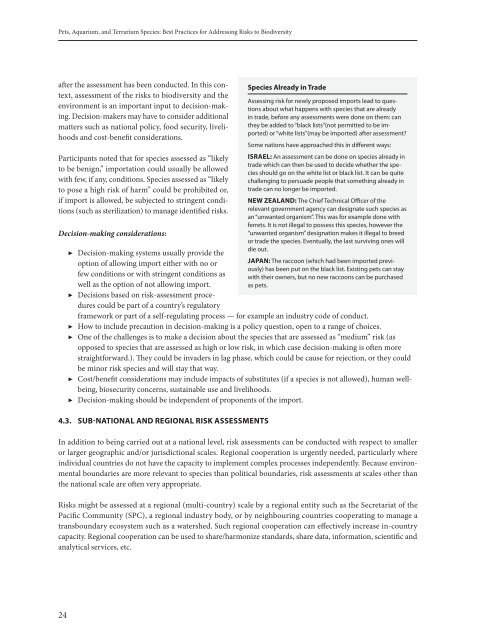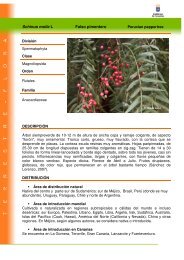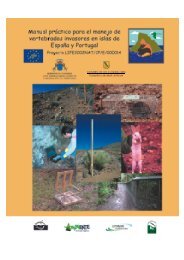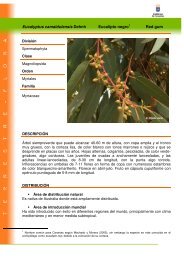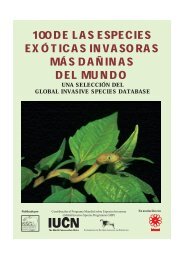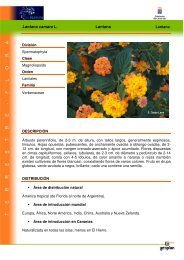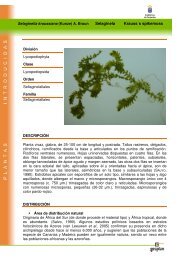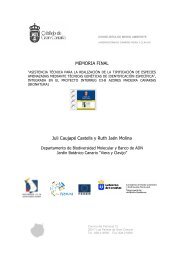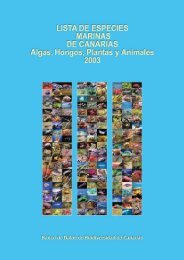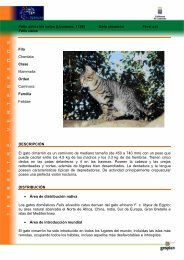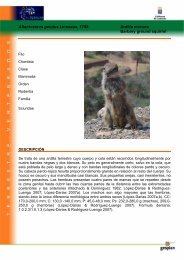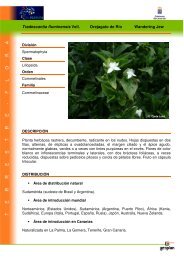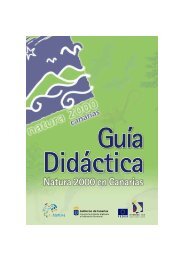Pets, Aquarium, and Terrarium Species - Convention on Biological ...
Pets, Aquarium, and Terrarium Species - Convention on Biological ...
Pets, Aquarium, and Terrarium Species - Convention on Biological ...
Create successful ePaper yourself
Turn your PDF publications into a flip-book with our unique Google optimized e-Paper software.
<str<strong>on</strong>g>Pets</str<strong>on</strong>g>, <str<strong>on</strong>g>Aquarium</str<strong>on</strong>g>, <str<strong>on</strong>g>and</str<strong>on</strong>g> <str<strong>on</strong>g>Terrarium</str<strong>on</strong>g> <str<strong>on</strong>g>Species</str<strong>on</strong>g>: Best Practices for Addressing Risks to Biodiversity<br />
after the assessment has been c<strong>on</strong>ducted. In this c<strong>on</strong>text,<br />
assessment of the risks to biodiversity <str<strong>on</strong>g>and</str<strong>on</strong>g> the<br />
envir<strong>on</strong>ment is an important input to decisi<strong>on</strong>-making.<br />
Decisi<strong>on</strong>-makers may have to c<strong>on</strong>sider additi<strong>on</strong>al<br />
matters such as nati<strong>on</strong>al policy, food security, livelihoods<br />
<str<strong>on</strong>g>and</str<strong>on</strong>g> cost-benefit c<strong>on</strong>siderati<strong>on</strong>s.<br />
Participants noted that for species assessed as “likely<br />
to be benign,” importati<strong>on</strong> could usually be allowed<br />
with few, if any, c<strong>on</strong>diti<strong>on</strong>s. <str<strong>on</strong>g>Species</str<strong>on</strong>g> assessed as “likely<br />
to pose a high risk of harm” could be prohibited or,<br />
if import is allowed, be subjected to stringent c<strong>on</strong>diti<strong>on</strong>s<br />
(such as sterilizati<strong>on</strong>) to manage identified risks.<br />
Decisi<strong>on</strong>-making c<strong>on</strong>siderati<strong>on</strong>s:<br />
▶▶<br />
Decisi<strong>on</strong>-making systems usually provide the<br />
opti<strong>on</strong> of allowing import either with no or<br />
few c<strong>on</strong>diti<strong>on</strong>s or with stringent c<strong>on</strong>diti<strong>on</strong>s as<br />
well as the opti<strong>on</strong> of not allowing import.<br />
▶▶<br />
Decisi<strong>on</strong>s based <strong>on</strong> risk-assessment procedures<br />
could be part of a country’s regulatory<br />
framework or part of a self-regulating process — for example an industry code of c<strong>on</strong>duct.<br />
▶▶<br />
How to include precauti<strong>on</strong> in decisi<strong>on</strong>-making is a policy questi<strong>on</strong>, open to a range of choices.<br />
▶▶<br />
One of the challenges is to make a decisi<strong>on</strong> about the species that are assessed as “medium” risk (as<br />
opposed to species that are assessed as high or low risk, in which case decisi<strong>on</strong>-making is often more<br />
straightforward.). They could be invaders in lag phase, which could be cause for rejecti<strong>on</strong>, or they could<br />
be minor risk species <str<strong>on</strong>g>and</str<strong>on</strong>g> will stay that way.<br />
▶▶<br />
Cost/benefit c<strong>on</strong>siderati<strong>on</strong>s may include impacts of substitutes (if a species is not allowed), human wellbeing,<br />
biosecurity c<strong>on</strong>cerns, sustainable use <str<strong>on</strong>g>and</str<strong>on</strong>g> livelihoods.<br />
▶▶<br />
Decisi<strong>on</strong>-making should be independent of prop<strong>on</strong>ents of the import.<br />
4.3. Sub-Nati<strong>on</strong>al <str<strong>on</strong>g>and</str<strong>on</strong>g> Regi<strong>on</strong>al Risk Assessments<br />
<str<strong>on</strong>g>Species</str<strong>on</strong>g> Already in Trade<br />
Assessing risk for newly proposed imports lead to questi<strong>on</strong>s<br />
about what happens with species that are already<br />
in trade, before any assessments were d<strong>on</strong>e <strong>on</strong> them: can<br />
they be added to “black lists”(not permitted to be imported)<br />
or “white lists”(may be imported) after assessment?<br />
Some nati<strong>on</strong>s have approached this in different ways:<br />
Israel: An assessment can be d<strong>on</strong>e <strong>on</strong> species already in<br />
trade which can then be used to decide whether the species<br />
should go <strong>on</strong> the white list or black list. It can be quite<br />
challenging to persuade people that something already in<br />
trade can no l<strong>on</strong>ger be imported.<br />
New Zeal<str<strong>on</strong>g>and</str<strong>on</strong>g>: The Chief Technical Officer of the<br />
relevant government agency can designate such species as<br />
an “unwanted organism”. This was for example d<strong>on</strong>e with<br />
ferrets. It is not illegal to possess this species, however the<br />
“unwanted organism” designati<strong>on</strong> makes it illegal to breed<br />
or trade the species. Eventually, the last surviving <strong>on</strong>es will<br />
die out.<br />
Japan: The racco<strong>on</strong> (which had been imported previously)<br />
has been put <strong>on</strong> the black list. Existing pets can stay<br />
with their owners, but no new racco<strong>on</strong>s can be purchased<br />
as pets.<br />
In additi<strong>on</strong> to being carried out at a nati<strong>on</strong>al level, risk assessments can be c<strong>on</strong>ducted with respect to smaller<br />
or larger geographic <str<strong>on</strong>g>and</str<strong>on</strong>g>/or jurisdicti<strong>on</strong>al scales. Regi<strong>on</strong>al cooperati<strong>on</strong> is urgently needed, particularly where<br />
individual countries do not have the capacity to implement complex processes independently. Because envir<strong>on</strong>mental<br />
boundaries are more relevant to species than political boundaries, risk assessments at scales other than<br />
the nati<strong>on</strong>al scale are often very appropriate.<br />
Risks might be assessed at a regi<strong>on</strong>al (multi-country) scale by a regi<strong>on</strong>al entity such as the Secretariat of the<br />
Pacific Community (SPC), a regi<strong>on</strong>al industry body, or by neighbouring countries cooperating to manage a<br />
transboundary ecosystem such as a watershed. Such regi<strong>on</strong>al cooperati<strong>on</strong> can effectively increase in-country<br />
capacity. Regi<strong>on</strong>al cooperati<strong>on</strong> can be used to share/harm<strong>on</strong>ize st<str<strong>on</strong>g>and</str<strong>on</strong>g>ards, share data, informati<strong>on</strong>, scientific <str<strong>on</strong>g>and</str<strong>on</strong>g><br />
analytical services, etc.<br />
24


